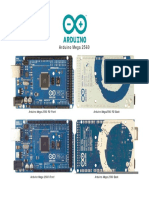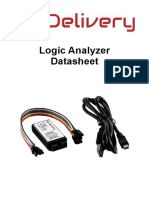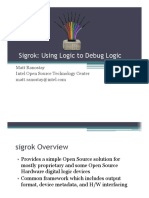ADC in Arduino
Uploaded by
NishantADC in Arduino
Uploaded by
NishantADC in Arduino
Introduction
When we interface sensors to the microcontroller, the output of the sensor many
of the times is analog in nature. But microcontroller processes digital signals.
Hence, we use ADC in between sensor and microcontroller. It converts an analog
signal into digital and gives it to the microcontroller.
There are many applications of ADC like in a biometric application, Environment
monitoring, Gas leakage detection etc.
Arduino Uno has 6 On-board ADC channels which can be used to read analog
signal in the range 0-5V.
It has 10-bit ADC means it will give digital value in the range of 0 – 1023 (2^10).
This is called as resolution which indicates the number of discrete values it can
produce over the range of analog values.
Digital Output value Calculation
ADC Resolution = Vref / ((2^n) - 1)
Digital Output = Vin / Resolution
Where,
Vref - The reference voltage is the maximum value that the ADC can convert.
To keep things simple, let us consider that Vref is 5V,
For 0 Vin, digital o/p value = 0
For 5 Vin, digital o/p value = 1023 (10-bit)
For 2.5 Vin, digital o/p value = 512 (10-bit)
ADC Pins of Arduino Uno
Arduino ADC pins
Functions for Arduino ADC
analogRead (pin)
This function is used to read analog value from specified analog pin.
pin - number of analog pin which we want to read
returns - digital value 0 – 1023
e.g. analogRead(A0) //read analog value at A0 channel
analogReference (type)
This function is used for configuring the reference voltage used for analog input.
Read Analog value using Arduino
Let’s write a program to read varying analog value generated using potentiometer which
is connected to A0 analog channel. Display the digital value on Serial monitor which we
got from the Arduino ADC.
Interfacing Diagram
Potentiometer connected Arduino ADC Channel
Sketch for reading analog value
int sensorPin = A0; // input pin for the potentiometer
int digitalValue = 0;// variable to store the value coming from the sensor
void setup() {
Serial.begin(9600);
}
void loop() {
digitalValue = analogRead(sensorPin);// read the value from the analog channel
Serial.print("digital value = ");
Serial.println(digitalValue); //print digital value on serial monitor
delay(1000);
}
Output on Serial Monitor
Note: If nothing is connected to analog input channel then the analogRead () function
return the noisy fluctuating value.
Read Analog Voltage using Arduino Uno
As ADC provide digital output which is proportional to analog value. To know what is
input analog value, we need to convert this digital value back to analog value through
program. To convert this digital value to analog input voltage,
Aout = digital value * (Vref/2^n – 1)
e.g. digital value = 512 and ADC is 10-bit with 5V Vref. But, we want to know that for
what analog voltage it is giving respective digital value. Then,
Aout = 512 * (5 V / 1023)
= 2.5 V
Sketch for reading Analog Voltage using Arduino
int sensorPin = A0; // select the input pin for the potentiometer
int digitalValue = 0; // variable to store the value coming from the sensor
float analogVoltage = 0.00;
void setup() {
Serial.begin(9600);
}
void loop() {
digitalValue = analogRead(sensorPin);// read the value from the analog channel
Serial.print("digital value = ");
Serial.print(digitalValue); //print digital value on serial monitor
//convert digital value to analog voltage
analogVoltage = (digitalValue * 5.00)/1023.00;
Serial.print(" analog voltage = ");
Serial.println(analogVoltage);
delay(1000);
}
Output on Serial Window
You might also like
- Cambridge IGCSE and O Level Computer Science Study and Revision Guide Second Edition (David Watson, Helen Williams, David Fairley) (Z-Library)93% (15)Cambridge IGCSE and O Level Computer Science Study and Revision Guide Second Edition (David Watson, Helen Williams, David Fairley) (Z-Library)211 pages
- Experiment # 4: ESP32 ADC - Read Analog Values With Arduino IDE100% (2)Experiment # 4: ESP32 ADC - Read Analog Values With Arduino IDE6 pages
- Microcontroller Systems (KON 309E) : Lecture Notes (WEEK 1)No ratings yetMicrocontroller Systems (KON 309E) : Lecture Notes (WEEK 1)8 pages
- Digital Temperature Meter Using PIC16F688No ratings yetDigital Temperature Meter Using PIC16F6883 pages
- LAB 3 - Arduino As Microcontroller: LED Bar Graph100% (1)LAB 3 - Arduino As Microcontroller: LED Bar Graph4 pages
- Atmel AVR Microcontroller Primer: Programming and InterfacingNo ratings yetAtmel AVR Microcontroller Primer: Programming and Interfacing194 pages
- Difference Between AVR, ARM, 8051 and PIC MicrocontrollersNo ratings yetDifference Between AVR, ARM, 8051 and PIC Microcontrollers16 pages
- STM32F30xx-31xx Standard Peripheral Library UM1581No ratings yetSTM32F30xx-31xx Standard Peripheral Library UM1581584 pages
- 113 115 Object Detection and Tracking Using Image Processing PDFNo ratings yet113 115 Object Detection and Tracking Using Image Processing PDF3 pages
- Automated Industrial Robot Path Planning For Pick and Plcae Applications FinalNo ratings yetAutomated Industrial Robot Path Planning For Pick and Plcae Applications Final1 page
- Temperature Sensing/Monitoring Using Lm35 & Atmega875% (4)Temperature Sensing/Monitoring Using Lm35 & Atmega86 pages
- Arduino and DS3231 Real Time Clock: Hardware RequiredNo ratings yetArduino and DS3231 Real Time Clock: Hardware Required6 pages
- Open-Loop and Closed-Loop Control of A DC Motor With Ni MyrioNo ratings yetOpen-Loop and Closed-Loop Control of A DC Motor With Ni Myrio15 pages
- ESP 32 Introduction: Subject-ESD Semester - III TA - Shilpa Marathe100% (1)ESP 32 Introduction: Subject-ESD Semester - III TA - Shilpa Marathe12 pages
- Water Level Indicator and Controller Using PIC Microcontroller100% (2)Water Level Indicator and Controller Using PIC Microcontroller11 pages
- 25.ACCESSIBLE DISPLAY DESIGN TO CONTROL HOME AREA NETWORKSDocumentNo ratings yet25.ACCESSIBLE DISPLAY DESIGN TO CONTROL HOME AREA NETWORKSDocument84 pages
- Speed Control of DC Motor Using Microcontroller100% (2)Speed Control of DC Motor Using Microcontroller5 pages
- Introduction To Microcontroller Arduino Tutorial100% (1)Introduction To Microcontroller Arduino Tutorial34 pages
- Experiment No. 1: Arithmetic & Logical Operations in PIC: To Perform Various Arithmetic and Logical Operations in PIC 16F877100% (1)Experiment No. 1: Arithmetic & Logical Operations in PIC: To Perform Various Arithmetic and Logical Operations in PIC 16F87714 pages
- Analog Electronics Ii: EMT 212/4 Semester 1 2006/2007100% (1)Analog Electronics Ii: EMT 212/4 Semester 1 2006/200727 pages
- SKEE 2742 Basic Electronic Lab: Experiment 1 Zener Diode100% (1)SKEE 2742 Basic Electronic Lab: Experiment 1 Zener Diode5 pages
- Lab05 - Controlling A DC Motor Using ArduinoNo ratings yetLab05 - Controlling A DC Motor Using Arduino6 pages
- Practical - 1 - : To Study Arduino Development BoardNo ratings yetPractical - 1 - : To Study Arduino Development Board5 pages
- CHP 5 Pic Micro Controller Instruction Set100% (1)CHP 5 Pic Micro Controller Instruction Set75 pages
- STM32 Nucleo Boards User Manual - ST PDFNo ratings yetSTM32 Nucleo Boards User Manual - ST PDF54 pages
- Science & Technology Month Celebration: Swift (Collated) Ano Mas Acceptable Camille?No ratings yetScience & Technology Month Celebration: Swift (Collated) Ano Mas Acceptable Camille?2 pages
- Supplemental Parts Information Index: Allison MT (B) 640, 643, 650, 653 Series On-Highway Transmissions Parts Catalog100% (1)Supplemental Parts Information Index: Allison MT (B) 640, 643, 650, 653 Series On-Highway Transmissions Parts Catalog130 pages
- Proportional Reducing Valves Rzgo, Hzgo, Kzgo: Pilot Operated, ISO 4401 Size 06, 10No ratings yetProportional Reducing Valves Rzgo, Hzgo, Kzgo: Pilot Operated, ISO 4401 Size 06, 104 pages
- Ethereum. A Store of Value With Cash FlowNo ratings yetEthereum. A Store of Value With Cash Flow4 pages
- Test Results Industrial Solar Technology Parabolic Trough Solar CollectorNo ratings yetTest Results Industrial Solar Technology Parabolic Trough Solar Collector140 pages
- 00 AGENDA Radioss Intro V2019 MAR29-2019No ratings yet00 AGENDA Radioss Intro V2019 MAR29-201922 pages
- Power of Resources For Graphic DesignersNo ratings yetPower of Resources For Graphic Designers45 pages
- Cambridge IGCSE and O Level Computer Science Study and Revision Guide Second Edition (David Watson, Helen Williams, David Fairley) (Z-Library)Cambridge IGCSE and O Level Computer Science Study and Revision Guide Second Edition (David Watson, Helen Williams, David Fairley) (Z-Library)
- Experiment # 4: ESP32 ADC - Read Analog Values With Arduino IDEExperiment # 4: ESP32 ADC - Read Analog Values With Arduino IDE
- Microcontroller Systems (KON 309E) : Lecture Notes (WEEK 1)Microcontroller Systems (KON 309E) : Lecture Notes (WEEK 1)
- Atmel AVR Microcontroller Primer: Programming and InterfacingAtmel AVR Microcontroller Primer: Programming and Interfacing
- Difference Between AVR, ARM, 8051 and PIC MicrocontrollersDifference Between AVR, ARM, 8051 and PIC Microcontrollers
- STM32F30xx-31xx Standard Peripheral Library UM1581STM32F30xx-31xx Standard Peripheral Library UM1581
- 113 115 Object Detection and Tracking Using Image Processing PDF113 115 Object Detection and Tracking Using Image Processing PDF
- Automated Industrial Robot Path Planning For Pick and Plcae Applications FinalAutomated Industrial Robot Path Planning For Pick and Plcae Applications Final
- Temperature Sensing/Monitoring Using Lm35 & Atmega8Temperature Sensing/Monitoring Using Lm35 & Atmega8
- Arduino and DS3231 Real Time Clock: Hardware RequiredArduino and DS3231 Real Time Clock: Hardware Required
- Open-Loop and Closed-Loop Control of A DC Motor With Ni MyrioOpen-Loop and Closed-Loop Control of A DC Motor With Ni Myrio
- ESP 32 Introduction: Subject-ESD Semester - III TA - Shilpa MaratheESP 32 Introduction: Subject-ESD Semester - III TA - Shilpa Marathe
- Water Level Indicator and Controller Using PIC MicrocontrollerWater Level Indicator and Controller Using PIC Microcontroller
- 25.ACCESSIBLE DISPLAY DESIGN TO CONTROL HOME AREA NETWORKSDocument25.ACCESSIBLE DISPLAY DESIGN TO CONTROL HOME AREA NETWORKSDocument
- Experiment No. 1: Arithmetic & Logical Operations in PIC: To Perform Various Arithmetic and Logical Operations in PIC 16F877Experiment No. 1: Arithmetic & Logical Operations in PIC: To Perform Various Arithmetic and Logical Operations in PIC 16F877
- Analog Electronics Ii: EMT 212/4 Semester 1 2006/2007Analog Electronics Ii: EMT 212/4 Semester 1 2006/2007
- SKEE 2742 Basic Electronic Lab: Experiment 1 Zener DiodeSKEE 2742 Basic Electronic Lab: Experiment 1 Zener Diode
- Practical - 1 - : To Study Arduino Development BoardPractical - 1 - : To Study Arduino Development Board
- Science & Technology Month Celebration: Swift (Collated) Ano Mas Acceptable Camille?Science & Technology Month Celebration: Swift (Collated) Ano Mas Acceptable Camille?
- Supplemental Parts Information Index: Allison MT (B) 640, 643, 650, 653 Series On-Highway Transmissions Parts CatalogSupplemental Parts Information Index: Allison MT (B) 640, 643, 650, 653 Series On-Highway Transmissions Parts Catalog
- Proportional Reducing Valves Rzgo, Hzgo, Kzgo: Pilot Operated, ISO 4401 Size 06, 10Proportional Reducing Valves Rzgo, Hzgo, Kzgo: Pilot Operated, ISO 4401 Size 06, 10
- Test Results Industrial Solar Technology Parabolic Trough Solar CollectorTest Results Industrial Solar Technology Parabolic Trough Solar Collector
































































































